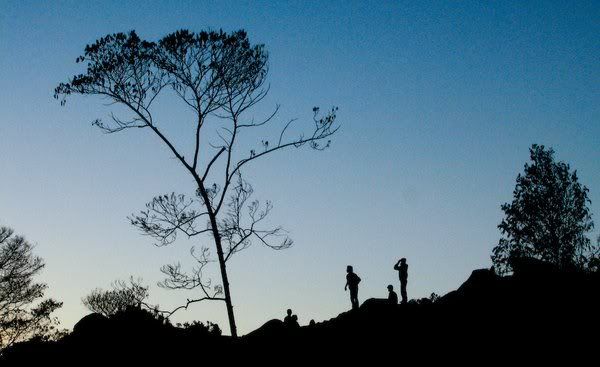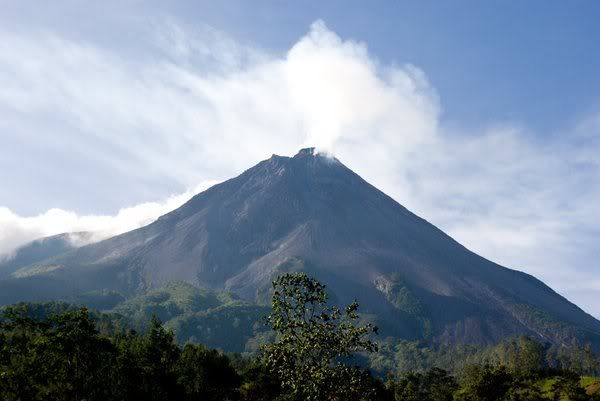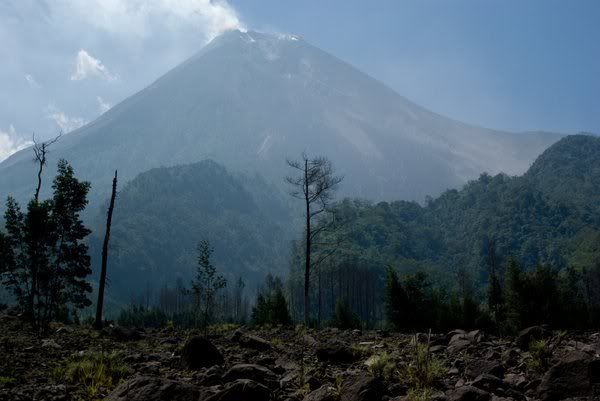Kasongan Village is one of the villages that serve as the Tourism Village in Yogyakarta Special Region. This village is a center-based pottery clay or loam. Soil type is indeed dominate the contours of the land Kasongan Village. Types of pottery produced by the Village Kasongan very varied. In the past, village residents Kasongan tend only to make tools for household needs only, like a pitcher (drinking water), kendil (a kind of pot that is used to store materials such as liquids, especially herbal medicine), barrel (the water), anglo (clay stove that at the bottom there is a place of charcoal burning fuel) and the like. But with the increasing economic value and aesthetic of pottery, Kasongan village residents also began to produce pottery for the craft. Today, the craft of pottery has been produced massively by Village residents Kasongan.
The origins Kasongan become industrial centers of pottery originated in the Dutch colonial period. In those days, in one area to the south of Yogyakarta city shocking events that have occurred to local residents, that is a horse owned by Dutch detectives found dead on the paddy field was owned by a citizen. This makes people scared to death. For fear of punishment, eventually releasing their land rights and ownership of land does not recognize it anymore. This was followed by other villagers. Land that has been released was also later recognized by the other villagers. Residents who fear finally silence around their home. Because they do not have paddy fields again, then to fill the day, they use whatever is around. One of them, they take advantage of existing soil, then ngempal-ngempal out and turned the land is not broken when put together. They then began shaping it into a variety of tools for the kitchen or children’s toys. Starting from activities such as making pottery that habit begins.
Basically, the process of making pottery is divided into two major parts, namely by way of printing to manufacture in large quantities (bulk) or directly by hand. The process of making by hand on a cylindrical ceramic (vases, pots, jars), carried out by adding little by little clay on top of a place that can be played. One of the craftsman’s hand will be on the inside while others were outside. By rotating pedestal, the automatically land at the top will form a cylinder with diameter and thickness scale is set through a process of suppression and withdrawal of the existing ground on both hands craftsmen. Making pottery or ceramics, ranging from the milling process, the formation of materials using the furniture, to the drying product usually takes 2-4 days. Products that have been dried and then burned, before finally finishing process is done by using a paint or paint the wall tile. A gallery in Kasongan usually a family business handed down from generation to generation. The craftsmen in the galleries are working collectively.
Ceramic manufacture at the present time involve the neighbors around the gallery owner’s residence, but the family is still responsible for material selection and supervision of production. At first, ceramic Kasongan village has no mode of design at all. However, the legend of the dead horse has inspired craftsmen to create a horse motif on their products, especially the horses pottery or tile carriers complete with a basket placed on a horse. In addition there are also motifs frogs, roosters and elephants. The times, marked by the entry of foreign cultural influences and modern through various media, has brought a change in Kasongan. After the region was first introduced by Kasongan Sapto Hudoyo circa 1971-1972 with a touch of art and commercial and large-scale commercialized by Sahid Ceramics around the 1980’s, now tourists can find a variety of different motifs on ceramics. In fact, travelers can book a kind of motive by the desire like peacocks, dragons, roses and many others.
Pottery crafts sold in the Village Kasongan varied, ranging from unique items for souvenirs are small (usually for a wedding gift), ornaments, pots for plants, interior (decorative lamps, sculptures, furniture, etc.), tables, chairs , and many more types. In fact, in its development, rural tourism product was also varied, including artificial flowers from banana leaves, bamboo furniture, mask-topengan and many others.
Results Kasongan pottery production now includes many species. No longer limited to just kitchen furniture (kendil, cauldrons, Pengaron, cormorant, and others) as well as children’s toys (musical instrument, frog, piggy bank). In the area Kasongan, will look ceramic galleries along the street that sells a variety of decorative items and souvenirs. Form and function also have varied, ranging from small ashtrays and flower vases or pots that are large, reaching the shoulders of adults. Ornamental goods are not only having the function, but also goods and souvenirs wedding decorations.
One of the products are quite famous is the statue of the bridal pair sitting side by side. This statue is known as the Loro Blonyo. The statue was adopted from a pair of statues bride’s Palace of Yogyakarta. In the Java language, loro means two or a pair, while Blonyo means makeup through a procession of bathing and dressed. However, the true meaning of Loro Blonyo still the question of the workers in Kasongan. The belief that the statue of Loro Blonyo will bring good luck and make a lasting domestic life when placed inside the house carrying a positive influence on selling this pair of ceramic sculpture.
Foreign tourists who like the model sculpture Loro Blonyo special order with various shapes such as a dancer, guitar player, model and so forth. His clothes were no longer wear traditional Javanese, but have adopted the typical clothes several countries. The motive of the most widely used motif Bali and Thailand. Terracotta warrior statue can be found here as well. Some of the ceramics gallery now has sold a pair of unique sculptures that continue to be produced by several forms and different models of this.
At the present time visitors, can find a variety of handicraft products besides pottery. Immigrants who opened the gallery in Kasongan also influence the development of the handicraft business here. Items sold are still including local handicrafts such as coconut wood crafts, handmade crafts plants that are dried or shellfish. Kasongan handicraft business grow with the flow and opportunities. However, the pottery remained a major milestone in the livelihoods of local residents. Ceramics with various shapes and modern motifs and even artistic, and other handicrafts, is the appeal Kasongan today. Kasongan has now become an interesting tourist attractions thanks to the wonderful things the expertise of local residents to process clay.
Kasongan Village is located in lowland areas in dukuh Kajen landless limestone, Bangunjiwo, Kasihan Bantul District, Yogyakarta Special Region.
To go Kasongan Tourism Village, tourists can use the public transport modes available land. If a visitor from Yogyakarta, Kasongan Village can be reached about 8 km to the southwest of the central city of Yogyakarta or about 15-20 minutes drive from downtown Yogyakarta. Means of transportation provided to the Village Kasongan include intercity buses in the province (Descending) majoring in Yogyakarta, Bantul and taxis.
In this tourist village, tourists can stay in homestay on site, shopping at craft stores that lined the streets along the neighborhood, and seeing the process of making various craft products and art pottery in the workshops. Price handicraft products offered vary greatly, depending on the type, model and size, with prices ranging between Rp 500 – Rp 2 million per seed (2008).
In the central region Kasongan pottery is also available from various bank ATMs spread over several points. ATM Distribution is indeed used as one strategy by the bank to approach the customers.
For travelers who want to specifically study the manufacture of pottery, provided some short courses organized by the houses or pottery gallery. The rates charged for participants to reach Rp. 50.000, – (2008) per person for one craft pottery.
The origins Kasongan become industrial centers of pottery originated in the Dutch colonial period. In those days, in one area to the south of Yogyakarta city shocking events that have occurred to local residents, that is a horse owned by Dutch detectives found dead on the paddy field was owned by a citizen. This makes people scared to death. For fear of punishment, eventually releasing their land rights and ownership of land does not recognize it anymore. This was followed by other villagers. Land that has been released was also later recognized by the other villagers. Residents who fear finally silence around their home. Because they do not have paddy fields again, then to fill the day, they use whatever is around. One of them, they take advantage of existing soil, then ngempal-ngempal out and turned the land is not broken when put together. They then began shaping it into a variety of tools for the kitchen or children’s toys. Starting from activities such as making pottery that habit begins.
Basically, the process of making pottery is divided into two major parts, namely by way of printing to manufacture in large quantities (bulk) or directly by hand. The process of making by hand on a cylindrical ceramic (vases, pots, jars), carried out by adding little by little clay on top of a place that can be played. One of the craftsman’s hand will be on the inside while others were outside. By rotating pedestal, the automatically land at the top will form a cylinder with diameter and thickness scale is set through a process of suppression and withdrawal of the existing ground on both hands craftsmen. Making pottery or ceramics, ranging from the milling process, the formation of materials using the furniture, to the drying product usually takes 2-4 days. Products that have been dried and then burned, before finally finishing process is done by using a paint or paint the wall tile. A gallery in Kasongan usually a family business handed down from generation to generation. The craftsmen in the galleries are working collectively.
Ceramic manufacture at the present time involve the neighbors around the gallery owner’s residence, but the family is still responsible for material selection and supervision of production. At first, ceramic Kasongan village has no mode of design at all. However, the legend of the dead horse has inspired craftsmen to create a horse motif on their products, especially the horses pottery or tile carriers complete with a basket placed on a horse. In addition there are also motifs frogs, roosters and elephants. The times, marked by the entry of foreign cultural influences and modern through various media, has brought a change in Kasongan. After the region was first introduced by Kasongan Sapto Hudoyo circa 1971-1972 with a touch of art and commercial and large-scale commercialized by Sahid Ceramics around the 1980’s, now tourists can find a variety of different motifs on ceramics. In fact, travelers can book a kind of motive by the desire like peacocks, dragons, roses and many others.
Pottery crafts sold in the Village Kasongan varied, ranging from unique items for souvenirs are small (usually for a wedding gift), ornaments, pots for plants, interior (decorative lamps, sculptures, furniture, etc.), tables, chairs , and many more types. In fact, in its development, rural tourism product was also varied, including artificial flowers from banana leaves, bamboo furniture, mask-topengan and many others.
Results Kasongan pottery production now includes many species. No longer limited to just kitchen furniture (kendil, cauldrons, Pengaron, cormorant, and others) as well as children’s toys (musical instrument, frog, piggy bank). In the area Kasongan, will look ceramic galleries along the street that sells a variety of decorative items and souvenirs. Form and function also have varied, ranging from small ashtrays and flower vases or pots that are large, reaching the shoulders of adults. Ornamental goods are not only having the function, but also goods and souvenirs wedding decorations.
One of the products are quite famous is the statue of the bridal pair sitting side by side. This statue is known as the Loro Blonyo. The statue was adopted from a pair of statues bride’s Palace of Yogyakarta. In the Java language, loro means two or a pair, while Blonyo means makeup through a procession of bathing and dressed. However, the true meaning of Loro Blonyo still the question of the workers in Kasongan. The belief that the statue of Loro Blonyo will bring good luck and make a lasting domestic life when placed inside the house carrying a positive influence on selling this pair of ceramic sculpture.
Foreign tourists who like the model sculpture Loro Blonyo special order with various shapes such as a dancer, guitar player, model and so forth. His clothes were no longer wear traditional Javanese, but have adopted the typical clothes several countries. The motive of the most widely used motif Bali and Thailand. Terracotta warrior statue can be found here as well. Some of the ceramics gallery now has sold a pair of unique sculptures that continue to be produced by several forms and different models of this.
At the present time visitors, can find a variety of handicraft products besides pottery. Immigrants who opened the gallery in Kasongan also influence the development of the handicraft business here. Items sold are still including local handicrafts such as coconut wood crafts, handmade crafts plants that are dried or shellfish. Kasongan handicraft business grow with the flow and opportunities. However, the pottery remained a major milestone in the livelihoods of local residents. Ceramics with various shapes and modern motifs and even artistic, and other handicrafts, is the appeal Kasongan today. Kasongan has now become an interesting tourist attractions thanks to the wonderful things the expertise of local residents to process clay.
Kasongan Village is located in lowland areas in dukuh Kajen landless limestone, Bangunjiwo, Kasihan Bantul District, Yogyakarta Special Region.
To go Kasongan Tourism Village, tourists can use the public transport modes available land. If a visitor from Yogyakarta, Kasongan Village can be reached about 8 km to the southwest of the central city of Yogyakarta or about 15-20 minutes drive from downtown Yogyakarta. Means of transportation provided to the Village Kasongan include intercity buses in the province (Descending) majoring in Yogyakarta, Bantul and taxis.
In this tourist village, tourists can stay in homestay on site, shopping at craft stores that lined the streets along the neighborhood, and seeing the process of making various craft products and art pottery in the workshops. Price handicraft products offered vary greatly, depending on the type, model and size, with prices ranging between Rp 500 – Rp 2 million per seed (2008).
In the central region Kasongan pottery is also available from various bank ATMs spread over several points. ATM Distribution is indeed used as one strategy by the bank to approach the customers.
For travelers who want to specifically study the manufacture of pottery, provided some short courses organized by the houses or pottery gallery. The rates charged for participants to reach Rp. 50.000, – (2008) per person for one craft pottery.











 Read more: http://epg-studio.blogspot.com/2009/06/widget-pengatur-halaman-untuk-kembali.html#ixzz1UA3ocoWT
Read more: http://epg-studio.blogspot.com/2009/06/widget-pengatur-halaman-untuk-kembali.html#ixzz1UA3ocoWT